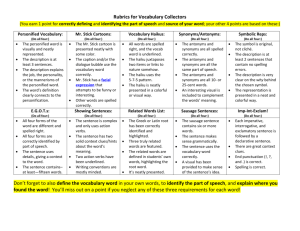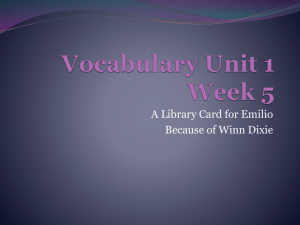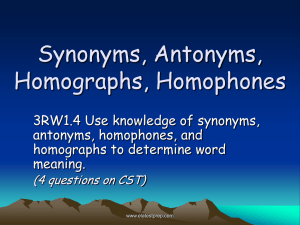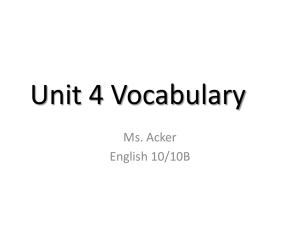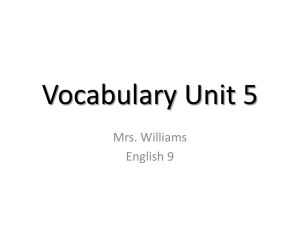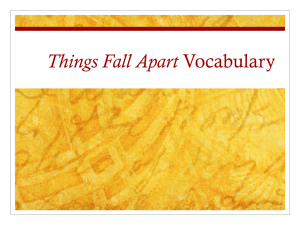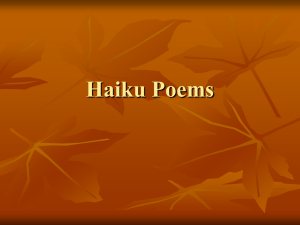Full-Page-Vocabulary-Rubrics-for-whole
advertisement
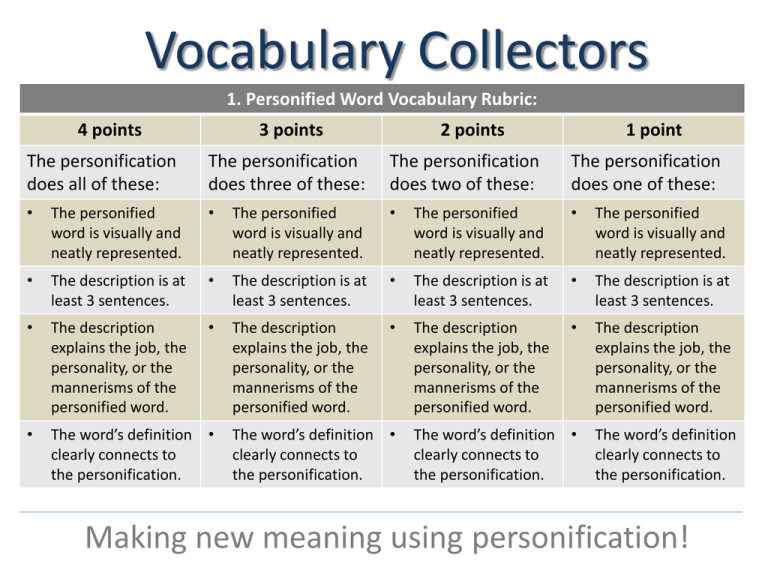
Vocabulary Collectors 1. Personified Word Vocabulary Rubric: 4 points 3 points 2 points 1 point The personification does all of these: The personification does three of these: The personification does two of these: The personification does one of these: • The personified word is visually and neatly represented. • The personified word is visually and neatly represented. • The personified word is visually and neatly represented. • The personified word is visually and neatly represented. • The description is at least 3 sentences. • The description is at least 3 sentences. • The description is at least 3 sentences. • The description is at least 3 sentences. • The description explains the job, the personality, or the mannerisms of the personified word. • The description explains the job, the personality, or the mannerisms of the personified word. • The description explains the job, the personality, or the mannerisms of the personified word. • The description explains the job, the personality, or the mannerisms of the personified word. • The word’s definition • clearly connects to the personification. The word’s definition • clearly connects to the personification. The word’s definition • clearly connects to the personification. The word’s definition clearly connects to the personification. Making new meaning using personification! Vocabulary Collectors 2. Nature Haiku Vocabulary Rubric: 4 points 3 points 2 points 1 point The haiku does all of these: The haiku does three The haiku does two of these: of these: The haiku does one of these: • The vocabulary word is spelled correctly and underlined. • The vocabulary word is spelled correctly and underlined. • The vocabulary word is spelled correctly and underlined. • The vocabulary word is spelled correctly and underlined. • The haiku juxtaposes two items or links to nature somehow. • The haiku juxtaposes two items or links to nature somehow. • The haiku juxtaposes two items or links to nature somehow. • The haiku juxtaposes two items or links to nature somehow. • The haiku uses the 5-7-5 pattern. • The haiku uses the 5-7-5 pattern. • The haiku uses the 5-7-5 pattern. • The haiku uses the 5-7-5 pattern. • The haiku is neatly presented in a colorful or visual way. • The haiku is neatly presented in a colorful or visual way. • The haiku is neatly presented in a colorful or visual way. • The haiku is neatly presented in a colorful or visual way. Making new meaning with haikus about nature! Vocabulary Collectors 3. Mr. Stick Cartoon Vocabulary Rubric: 4 points 3 points 2 points 1 point The Mr. Stick cartoon The Mr. Stick cartoon The Mr. Stick cartoon The Mr. Stick cartoon does all of these: does three of these: does two of these: does one of these: • The Mr. Stick cartoon • is presented neatly with some color. • The caption and/or the dialogue bubble use the vocabulary word correctly. • Mr. Stick has a facial • expression that attempts to be funny or interesting. • Other words are spelled correctly. • • The Mr. Stick cartoon • is presented neatly with some color. The caption and/or the dialogue bubble use the vocabulary word correctly. • Mr. Stick has a facial • expression that attempts to be funny or interesting. Other words are spelled correctly. • The Mr. Stick cartoon • is presented neatly with some color. The caption and/or the dialogue bubble use the vocabulary word correctly. • Mr. Stick has a facial • expression that attempts to be funny or interesting. Other words are spelled correctly. • The Mr. Stick cartoon is presented neatly with some color. The caption and/or the dialogue bubble use the vocabulary word correctly. Mr. Stick has a facial expression that attempts to be funny or interesting. Other words are spelled correctly. Making new meaning through cartoons with context! Vocabulary Collectors 4. Symbolic Representation (Metaphor) Vocabulary Rubric: 4 points The chosen symbol does all of these: 3 points The chosen symbol does three of these: 2 points The chosen symbol does two of these: The selected symbol • is original, not cliché. 1 point The chosen symbol does one of these: • The selected symbol • is original, not cliché. The selected symbol • is original, not cliché. • The description is at least 2 sentences that contain no spelling errors. • The description is at least 2 sentences that contain no spelling errors. • The description is at least 2 sentences that contain no spelling errors. • The description is at least 2 sentences that contain no spelling errors. • The description is very clear on the why behind the chosen symbol. • The description is very clear on the why behind the chosen symbol. • The description is very clear on the why behind the chosen symbol. • The description is very clear on the why behind the chosen symbol. • The metaphor is presented in a neat and colorful way. • The metaphor is presented in a neat and colorful way. • The metaphor is presented in a neat and colorful way. • The metaphor is presented in a neat and colorful way. The selected symbol is original, not cliché. Making new meaning with a well-explained metaphor! Vocabulary Collectors 5. Showing Sentences with Action Verbs Vocabulary Rubric: 4 points 3 points 2 points 1 point The original showing sentence does all: The original showing The original showing sentence does three: sentence does two: The original showing sentence does one: • The sentence only uses action verbs. • The sentence only uses action verbs. • The sentence only uses action verbs. • The sentence only uses action verbs. • The sentence has two solid context clues/hints about the word’s meaning. • The sentence has two solid context clues/hints about the word’s meaning. • The sentence has two solid context clues/hints about the word’s meaning. • The sentence has two solid context clues/hints about the word’s meaning. • Two verbs have been • underlined & labeled as transitive or intransitive. Two verbs have been • underlined & labeled as transitive or intransitive. Two verbs have been underlined & labeled as transitive or intransitive. • Writing conventions are close to flawless. • Writing conventions are close to flawless. • Two verbs have been • underlined & labeled as transitive or intransitive. Writing conventions are close to flawless. • Writing conventions are close to flawless. Making new meaning with a verb-packed showing sentence! Vocabulary Collectors 6. Greek & Latin Root Analysis & Related Words Vocabulary Rubric: 4 points 3 points 2 points 1 point The root analysis does all of these: The root analysis does three of these: The root analysis does two of these: The root analysis does one of these: • The Greek or Latin root has been correctly identified and highlighted. • The Greek or Latin root has been correctly identified and highlighted. • The Greek or Latin root has been correctly identified and highlighted. • The Greek or Latin root has been correctly identified and highlighted. • Three truly related words are featured. • Three truly related words are featured. • Three truly related words are featured. • Three truly related words are featured. • The related words are defined in the student’s own words, highlighting the root word’s meaning. • The related words are defined in the student’s own words, highlighting the root word’s meaning. • The related words are defined in the student’s own words, highlighting the root word’s meaning. • The related words are defined in the student’s own words, highlighting the root word’s meaning. • It’s neatly presented. • It’s neatly presented. • It’s neatly presented. • It’s neatly presented. Making new meaning with an analysis of etymological roots! Vocabulary Collectors 7. Four Antonyms & Four Synonyms Vocabulary Rubric: 4 points 3 points 2 points 1 point The antonym/synonym The antonym/synonym The antonym/synonym The antonym/synonym list does all of these: list does 3 of these: list does two of these: list does one of these: • The antonyms and synonyms are all spelled correctly. • The antonyms and synonyms are all spelled correctly. • The antonyms and synonyms are all spelled correctly. • The antonyms and synonyms are all spelled correctly. • The antonyms and synonyms are all the same part of speech. • The antonyms and synonyms are all the same part of speech. • The antonyms and synonyms are all the same part of speech. • The antonyms and synonyms are all the same part of speech. • The antonyms and synonyms are all 10or 25-cent words. • The antonyms and synonyms are all 10or 25-cent words. • The antonyms and synonyms are all 10or 25-cent words. • The antonyms and synonyms are all 10or 25-cent words. • The antonyms and synonyms are presented in a neat and colorful way. • The antonyms and synonyms are presented in a neat and colorful way. • The antonyms and synonyms are presented in a neat and colorful way. • The antonyms and synonyms are presented in a neat and colorful way. Making new meaning with a trip to the thesaurus! Vocabulary Collectors 8. E.G.O.T. and Silly E.G.O.T. Sentence Vocabulary Rubric: 4 points 3 points 2 points 1 point The E.G.O.T. and the sentence do all: The E.G.O.T. and the sentence do three: The E.G.O.T. and the sentence do two: The E.G.O.T. and the sentence do one: • All four forms of the word are different and spelled right. • All four forms of the word are different and spelled right. • All four forms of the word are different and spelled right. • All four forms of the word are different and spelled right. • All four forms are correctly identified by part of speech. • All four forms are correctly identified by part of speech. • All four forms are correctly identified by part of speech. • All four forms are correctly identified by part of speech. • The sentence uses details, giving a context to the word. • The sentence uses details, giving a context to the word. • The sentence uses details, giving a context to the word. • The sentence uses details, giving a context to the word. • The EGOT is neatly presented in a neat & colorful way. • The EGOT is neatly presented in a neat & colorful way. • The EGOT is neatly presented in a neat & colorful way. • The EGOT is neatly presented in a neat & colorful way. Making new meaning by learning a word’s different forms! Vocabulary Collectors 9. Sausage Sentence Vocabulary Rubric: 4 points 3 points 2 points 1 point The Sausage Sentence does all of these: The Sausage Sentence does three of these: The Sausage Sentence does two of these: The Sausage Sentence does one of these: • The sausage • sentence contains six or more words. The sausage • sentence contains six or more words. The sausage • sentence contains six or more words. • The sentence makes sense. • The sentence makes sense. • The sentence makes sense. • The sentence makes sense. • The sentence uses the vocabulary word correctly. • The sentence uses the vocabulary word correctly. • The sentence uses the vocabulary word correctly. • The sentence uses the vocabulary word correctly. • A visual has been provided to help make sense of the sentence’s idea. • A visual has been provided to help make sense of the sentence’s idea. • A visual has been provided to help make sense of the sentence’s idea. • A visual has been provided to help make sense of the sentence’s idea. The sausage sentence contains six or more words. Making new meaning by using the word in a clever sentence! Vocabulary Collectors 10. Imper-Inter-Exclam Sentence Sets Vocabulary Rubric: 4 points 3 points 2 points 1 point The Imper-InterExclam does all of these: The Imper-InterExclam does three of these: The Imper-InterExclam does two of these: The Imper-InterExclam does one of these: • Each imperative, interrogative, and exclamatory sentence is followed by a declarative sentence. • Each imperative, interrogative, and exclamatory sentence is followed by a declarative sentence. • Each imperative, interrogative, and exclamatory sentence is followed by a declarative sentence. • Each imperative, interrogative, and exclamatory sentence is followed by a declarative sentence. • There are great context clues. • There are great context clues. • There are great context clues. • There are great context clues. • End punctuation (!, ?, and .) is correct. • End punctuation (!, ?, and .) is correct. • End punctuation (!, ?, and .) is correct. • End punctuation (!, ?, and .) is correct. • Spelling is correct. • Spelling is correct. • Spelling is correct. • Spelling is correct. Making new meaning by using the different sentence types!
